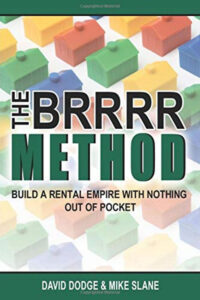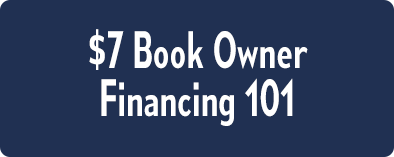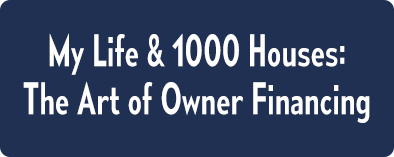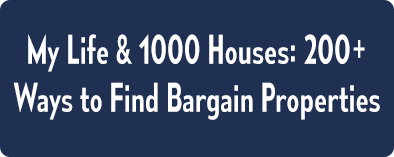PODCAST
Wholesaling Real Estate Using The BRRRR Method With David Dodge
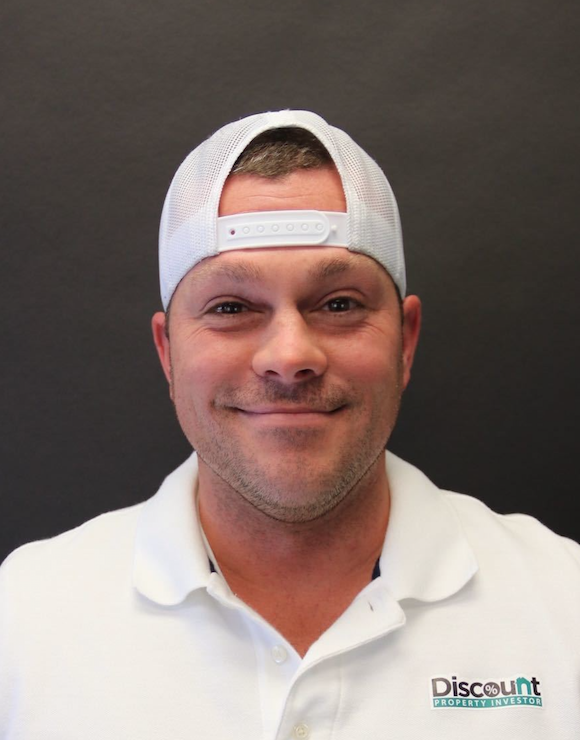

Mitch Stephen chats with
David Dodge
Episode 468: Wholesaling Real Estate Using The BRRRR Method With David Dodge
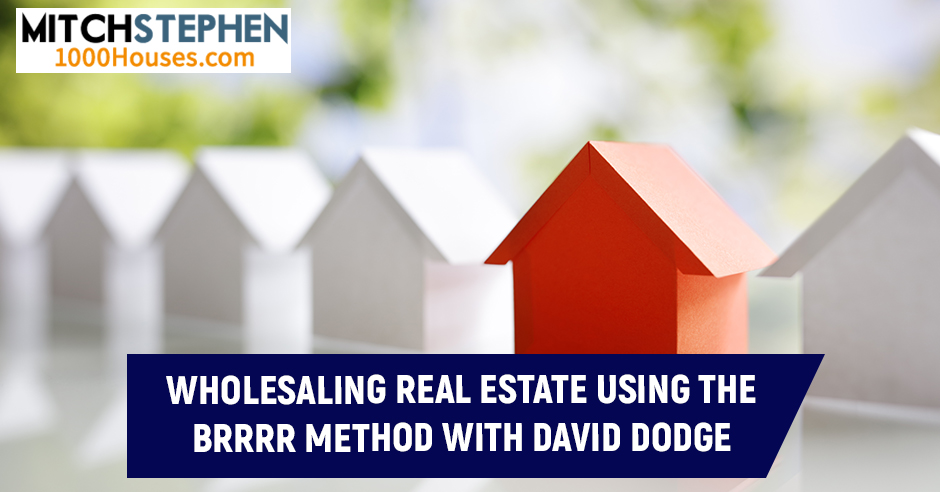
You’re in one of only three places: you’re currently in a crisis, coming out of a crisis, or you’re headed into one. David Dodge, the owner of Discount Property Investor, shares his extensive experience in wholesaling real estate with you today so that you can always win wherever you are in that continuum. In this episode, David discusses with Mitch Stephen their shared life-changing experience with the Multipliers Mastermind, the crazy condition the market’s in due to people leaving the Blue States for the Red States, and the marketing strategies they use to sell property. David also explains how the BRRRR method of investing works. Join in the conversation and discover how you can use David’s and Mitch’s experiences to pivot and succeed in your own market.
—
I’m here with my friend, David Dodge. We have been on vacation over in Tulum together in our mastermind. He’s been to my ranch and we’ve hunted together. He’s an overall great guy. I’m glad that he’s here because I haven’t had him on for a while. He’s also an educator but looking for the right person for the right fit. He’s not a hyper salesman. He’s in it for the right reasons. How are you doing, David?
I’m doing awesome, Mitch. Thanks for having me. It’s good to see you down in Mexico.
We got some things done. Everyone thinks we went down there to party. We didn’t party that hard. We did a lot of work.
We did a ton of work. At that particular mastermind, the Multipliers that we were at, that was my third year and it’s you‘re first. I’m super happy to have you in that group. The two previous years, it was a little bit more real estate-focused. In 2021, we didn’t even talk real estate at all, but I enjoyed it. It’s getting to know everybody in the group and it highlighted to me that everybody is going through something. If we’re either not in a crisis, we’re exiting one, or we’re probably about to be in one.
You need a place to get vulnerable where you can drop your guard and know that people aren't going to judge you. Share on XYou’re either headed into a crisis, you’re in a crisis, or coming out of a crisis.
Even the most successful of us have problems. I often try to compare myself to people and it’s probably not the best trade or habit that I have, but it was eye–opening to know. You are one of them that I really look up to and respect. They don’t have a perfect life either. People have struggles.
Just to be clear, the Multipliers was there to help successful people keep from imploding because of the external throes of life, not just the business problems. The business problems are enough to make you implode if your business isn’t going right. Even if your business is running like a train down a track, which mine is. It’s doing well. I’m surprised every day with COVID and the chaos out there that I’m still running on track. I did 83 houses in 2020. Short of my normal 100 but it was still a great year. Going into 2020, I had no idea how it was going to end up. I was scared to death but it was good. My particular issue is my spouse has been several years into Parkinson’s and you’re talking about 24–hour care and being there and all this other stuff. It’s a heavy load and I would share that with 50 grown men in a confidential arena. Men brought all kinds of issues there.
I left there feeling very good about myself. Not because I’m in a crisis necessarily, but to know that not everybody is perfect. People struggle and have internal stuff going on and it’s okay. That’s normal. It’s not abnormal is a good way to word it.
What was abnormal about that meeting was 50 men took down their guard and got down to some tough stuff. It was nice that you weren’t judged there. I left there feeling like I had 50 friends. I didn’t get to meet them all because too short of time, but I got to meet a lot of them. We got to meet each other through each other’s presentation if you want to call it that or share your story. Even the ones I didn’t meet, I got to know pretty good.
Everybody in that group is a rock star in my eyes. Every single one of those guys there. Even the ones that aren’t necessarily doing crazy real estate stuff, they have a big impact in some way, shape, or form on me by what they’re doing. The value they’re providing and the businesses that are in. It’s funny because we didn’t talk a lot about real estate in 2021 and even 90% of that group are real estate investors. Not all of us in there. There are probably 6 or 8 guys that aren’t. I told Chris Arnold when we were leaving, I go, “This was the best year yet.“ He goes, “You told me that the last two years.“ I go, “It is. It’s a phenomenal group. I’m proud to be a part of it.“
There was a lot of conversation about real estate in the halls even if we were at the beach. There were a lot of talks externally but when we got together, there were a lot of other things that needed to be fixed. Everyone pretty much had a handle on the business, 90% of the people. The other 10% came in looking for some help for the business. That’s cool, too. I was astounded. The reason why Scott Orban and Chris Arnold started that group is because they interviewed a bunch of men and said, “You have a place to go where you can let down your guard and talk about your life from the good things down to the bad or horrible things. Some place where you can go and get real with some real people, get it out, and figure out what to do.” That’s the reason why I signed up. I knew I was heading into this personal struggle at home with my wife’s health. I needed a place to go and I didn’t have a place to go. They interviewed all these men and 85% of them said they didn’t have a place like that to go. I was one of them saying, “I don’t have a place like that to go,“ so I went there.
It’s a place gets vulnerable. Drop your guard and know that people aren’t going to judge you. Instead, they would rather you come out with that stuff so they can do what they can to help you. Oftentimes, you’re not even looking for advice. You’re looking for a place to let some of that stuff out. I love that group, Mitch and I was fortunate enough to build and do a little intro for you when you joined, but I am happy with that group. I’m excited to be a part of it.
If we cause a rush over there, is they’re only going to take 50 people max. People are going to come and go every year, but it’s not an easy group to get into either.
I’ve been invited to a couple of other groups with 100 or close to 200 people and I’ve turned them down because it’s too big. Fifty may seem a lot of people but it’s really not. It’s hard to get around the room with 50 people on the first event. I get it but this is something that they’re going to keep going for a long time. I love the fact that they kept it.
We weren’t designed to talk about this, but maybe this what we’re supposed to talk because that’s what we’re going to talk. One of the things about the group was they only have that one meeting every year in February in Tulum. Every month, they have some place to go and a handful of guys go. I came down to the Frio River one time close to my house before I was a member that was me down there. There are like 8, 9, or 10 people. I got a small taste of the people that were going to be in this room. I was pretty much sold before I went, but after I went. Every month there are people having things to do. I can’t have all 50 people, but I could have ten people that I run through something.
I got back in town from Omaha, Nebraska. You obviously know I’m out of St. Louis, but the readers may not. I’m located out of St. Louis, Missouri. I’m a Midwest guy, but there are two guys in The Multipliers Mastermind that live in Omaha and they were having a conference Monday and Tuesday. The first day, Monday, was all about investors and investing. Their audience was a bunch of real estate agents that wanted to make the pivot from being an agent to an investor. They invited me up. I got to go, present with Clint, and visit with Jeff, the other two guys in that market. It was so fun. As you said, there’s always something going on outside of the main event in February with all 50 of the guys. Every couple of weeks where somebody will post something and get together. They’re like little breakaways and they could be anywhere from 3 people to maybe 15 people, give or take, but I love that group. It‘s very cool.
As entrepreneurs, you can get stuck in your own box. As you said, measuring yourself by other people and not feeling like you’re up to speed, we shouldn’t measure ourselves by anybody else. We should be competing with ourselves every month and year.
It’s a hard thing to do. It’s easier said than done. Some of these guys in the group that I’m thinking are beasts in the business and they are, by all means, but not everything goes to plan all the time. Shit happens and that’s totally normal. We said it early on in this episode but we’re either getting ready to enter a crisis or in one currently, or we’re starting to come out of one. It’s always one of those three.
It’s a sad statement but you can’t deny it. That’s the way it was. If you’re running smoothly, wait around a little while. Things will start to break. It’s the nature of the world. You can’t help it. That’s the task that we have at hand is to mitigate the throes of life that happen week–by–week, month–by–month, year–by–year. If you don’t morph in any business, the business will die. It’s the same for your own human personal self. If you’re not growing or learning to change, adapt, and get better at stuff, then it’s a hard place to be. You have to adapt and overcome all the time.
Mitch, I’m glad we talked about that. I also want to talk about how crazy our market is.
Speaking of how to adapt and overcome, here we are.
Mitch and I are doing this episode on March 23rd, 2021. I’m looking on Zillow and looking at the home values based upon where they were a year ago and where they are now. I pulled your market. San Antonio had an 8%. It’s 7.9% to be exact, I call it 8% increase in home values in one year. That’s actually on the low–end of some of these markets that I started typing in. For instance, in my city St. Louis, the city itself had a 15% increase in home values in one year. St. Louis is one of two places in the US with a city and a County. Our County has seen a 9.7% increase, call it 10%. 15% in the city, 10% in the County, and some of the ones that popped out at me were Phoenix, Arizona. It’s 19.7% increase in home values. Los Angeles, 10%. New York was low at only 2.2%, but that’s probably the norm. Chicago is 8%. Miami was 6.5%. In general, the market is going crazy. Inventory is at an all–time low, which is crazy hard to believe but that’s a nationwide statistic.
I talked to a realtor and they said they had an open house on the day after they hit the MLS listing. Thirty-five people came in and had thirteen offers over the asking price. They’re making people sign agreements that if the house comes in over appraisal, the buyer has to bring the cash. The difference between the appraisal and the sales price.
I was looking at a couple of properties before we jumped on. I looked at two of them. I made an offer on one. That’s good. These were the bull of the market. The agent who brought us the lead, it is one of her friends who owned them bulk was telling me that she got done with a listing. There were 97 offers on a listed property within 24 hours of it hitting the market. I said, “What was this? It’s like some crazy mansion. They were giving away a half–off.“ She goes, “No, this was a three bed, one bath house in downtown St. Louis.” I don’t even live downtown. It’s quite dangerous. I like to live in the County. It was a three–bedroom, one–bath house that was like decent size, but not massive, like 1,600 feet. They had 97 offers. She said the exact same thing. She said 3/4 of those people that made those offers made offers over asking. They had put in their offer that the difference of what it will appraise for and what they offered, they guaranteed in cash.
I was trying to find a house for my niece under $200,000. It was in San Antonio. It was a real decent house 1,500, 1,600, 1,700 square feet, 3, 2 driveway, garage, backyard, front yard, real decent neighborhood and good school district. I got demoralized. If you weren’t there the day that it hit the market and was making the offer, no contingencies, and all that stuff. I said, “You need to wait until this market cools down. It’ll come back down.“ I don’t know that it’s coming back down. I know the people are moving from someplace to here. A lot of people are leaving blue states to the red states and you can damn near see the traffic coming down the highway. I don’t know. These prices are ever going to go down again.
Not everything goes according to plan all the time, and that's totally normal. Share on XI only pulled up statistics here. I’m going over here on Zillow. You can go over to Zillow and you can type in home values. It’ll give you historical data. San Francisco was the only one I typed in that had a negative value. They saw one year. In 2020 and 65 days. They saw a 3.2% decrease. People are leaving the blue states, as you said, to the red states. That was the only market that I pulled out of about ten that had a negative. Everything else was high.
That being said, you’re real estate investors. That’s what you do for a living. You don’t have a plan B. How are you finding houses?
It has got more challenging over the months than it ever has been. I’ve been investing in real estate for sixteen years but I’ve only been at this full-time for probably 6 or 7, and it has got more challenging. We’re still using the same techniques that we were using before. We’re doing a lot of driving for dollars. We do bandit signs. Whenever we do our driving for dollars, we will send postcards. I have a whole stack of them, but I got to get to town working on it. I got to start skip tracing these and start calling those sellers. I’m going to get on that. We’ll do that. We also have some virtual assistants that help us with cold calling. I have three of them that work twenty hours a piece a week. That’s 60 hours a week of outbound cold calling. We do somewhere between 20 and 30 hours a week of outbound cold texting. I used to have radio ads, but at the time I did my radio ads, years ago, I was the only person on the radio. Now, there are six people on the radio.
How much did you spend in that year?
I spent $3,000 a month. I had a pretty low budget. That was two stations that I was on and I had two ads per station per day. There were one–minute ads. That’s Monday through Friday, 7:00 AM to 6:00 PM. It was early, not late, not on the weekends.
When you go into radio, it’s not something you can do for 30 days and judge it. If you’re not going to get in it for a year, don’t even get in. Did you notice it starts to pick up towards the end of the year and all of it started to pay?
It took about 3 or 4 months for it to pick up. People needed to hear that ad 20, 30 times before they would call. The cool thing about radio is it is instant. You turn it on and you’re going to start getting leads. That doesn’t mean that you’re going to have the highest return. It took 4 or 5 months to see it peak off. I did it for close to 1.5 years. After about a year, it was still doing great. What happened is people started coming in and competing with me, and it started trickling down. When it got down below where I had first started, I said, “I‘m going to hold off.” I went ahead and pulled that off. I put that into my cold calls. I wasn’t doing much cold calling at that time. I started picking up cold calling heavy about the same time that I quit doing the radio. I’ll do more radio in the future. I’m not going to be doing it on those stations where there are six people already on it. I’m going to try to find some of these smaller stations.
He did something that was working, then it stops working. He has to morph again. It’s constant change.
You‘ve got to change. You’ve got to innovate. Other than that, cold calling, cold texting, and direct mail. I called my AdWords because I haven’t run AdWords in two years. I know that there’s a ton of potential in AdWords, especially now that everything is virtual. I’m going to start doing a small campaign with him. Nothing crazy. It’s $2,500 to $3,000 a month or something like that. Now is not the time to slow your marketing down. Now is the time to increase it and pick it up because it’s getting harder to find these deals. The ten cities here that I’ve run the overall market overview. Let’s call it a market overview of where the prices have gone year to date. I’m average from my little sheet, around 9% or 10%. It’s amazing. Property values are going up like crazy. In some areas, they’re going up 2% or 3% a month. What does that mean for us? It means that people are getting harder to find great off-market deals. People know that their property has value.
There are two reasons. One is there’s more competition in our business than ever. There’s a lot of free information. They’ve glorified this on HGTV. They are not showing you how much work it takes.
I often discount that. I’m happy that you brought that up. HGTV has been around for many years but the whole flipping craze is the last 5 or 10, but every day, there is more competition than there was the day before. That’s a big factor. The other factor is that most people don’t know how to run comps. They don’t know much, but what they do know is how to pull up a Zillow’s Zestimate. When they see that Zestimate goes from $140,000 to $160,000 in a year, they’re like, “My house is worth $20,000 more.“ It doesn’t necessarily mean that it is or isn’t. In their head, they’ve convinced themselves that they should get more for their property. When investors come in and we say, “Your house may be worth $160,000. That’s the ARV. That’s what it would be worth after all these repairs but you need to put $20,000, $30,000 or $40,000 into getting it to be there.” They think, “That’s what you think. Maybe the next guy won’t.” They’ll say, “I’ll give you that $140,000 or $150,000, even though it needs repairs. The ARV is $160,000.” People are getting wiser.
Here’s a tidbit. You find properties that have an extra lot or some extra component besides the lot that the house is on and Zillow doesn’t give credit for the extra lot. It only gives the estimate for the house and the lot. If it has an extra lot or two with it, it’s not counting that in the deal. I would go through scanning for those. I did the SEO thing to get up high in the SEO. What I found was it didn’t work for me. Tell me if you figured the same thing. One is it’s expensive because there’s a lot of competition for these keywords.
In SEO, it takes a long time for it to work and it has to be a very consistent thing. You can’t do it for 1 or 2 years and get a great ranking. You might for 1, 2 or 3 weeks but if you’re not consistent with it, it’s difficult to hold those ranks.
The problem is even when I finally got there and I was number three on the page, I’m going into a house and whoever these people are that are looking up on the internet to sell their house to someone, they’re calling everybody on the first two pages. There are five people coming out when I’m going in. When I’m coming out, there are five more people coming in. It was a bidding war. I’m paying a lot of money to be bidding against everybody. Quite frankly, some of this money coming from California, New York, and Ford or whatever, they’re paying way too much for these houses.
I did a full analysis on Texas, in general. San Antonio, we said earlier, with 7.9%, Austin is 15.8%, Dallas is 9.2%, and Houston is 9.5%. It‘s unbelievable. We’re averaging 10%. I would think Texas, in general, is closer to 12%.
Texas isn’t like California or Florida where they have these huge spikes and divots. We’ve always been steady.
Missouri is the same way. It’s been very steady. In St. Louis, the County was 9%, call it 10%. The city was about 15%. I also own some property in Columbia, Missouri, which is about 100 miles West. I’m curious to see they had an 8% and Columbia was one of those markets where in 2008, it didn’t even decrease any. It leveled out and stayed there for 5 or 6 years. Even that market has gone up 8%. It’s wild.

Wholesaling Real Estate: You’ve got to change. You’ve got to innovate.
I failed in this interview. I didn’t tell anybody who you were. David has 600 or 700 hotels and 150 rental properties.
I sold some this 2021 because of these prices. In 2020, I had about 75 properties. The door count was close to 120. I’m down to 33 or 34 properties. We sold them off for three reasons. I had two partners. I’m down to having one partner. I’m happy about that. One of our partners was an older guy who was in his 60s and got a couple of million dollars. He was chilling. He was like, “Guys, I still want to work with you. I still want to be a part of this but I don’t want to continue this. I don’t want to be signing on these loans for these rentals. Why don’t you guys try to figure out a way to buy me out.”
We did. We had to sell some of our portfolios to do so and we had racked up. I’m not afraid to admit this at all. This goes back to the very first part of this show. In order for us to get over 100 doors and be at 75 plus properties, we were using the BRRRR method but in the beginning of anything, there’s a huge learning curve and we were leaving $20,000 to $25,000 in properties. After six months to a year, we got that number down to about $10,000 and then another six months to a year, we got that number down to $5,000 and now we’re averaging zero. We can do this and I’m confident over the 1, 2, or maybe 3 years that I’m going to get right back to $200,000 or $300,000.
You had to go back and sell those properties. You had all your own cash to get it back in your pocket. That’s the profit but this is smart because we sold a package of about 40 notes, give or take 1 or 2. We knitted a big number. The reason why is, I feel like we’re headed into a shit show. I don’t know when. I’ve been feeling that for a long time and it seemed like to me, it should have already happened. I don’t know what’s holding it up. Anyways, at some point, it’s more fun to say I have 75 houses, 100 houses, 125 houses and you make this thing tall. This is the analogy I use. It’s more fun to go high because the view gets better. If you don’t stop sometimes and sell off the top or the very best of what you have, get down, and expand your base instead of looking like a skyscraper, it looks like a pyramid. Let me tell you about storms in a skyscraper. Storms blow skyscrapers over. Storms do not blow pyramids over.
Our analogy was very similar. It was like a tree. It’s like our tree had grown tall, but the base of the tree wasn’t sturdy enough to sustain where we were. It was in the current day and time. If the market were to turn or something would happen, we would be in a lot of trouble.
If it caught some big winds, you’re going to be uprooted.
Number one, we wanted to get one of our partners bought out, which was a good thing because we’re still like the best of friends. He’s still one of my number one lenders. Number two, we wanted to get out of debt. We had about $750,000 on our line of credit that was maxed out, fully borrowed, fully leveraged on that line, and it was $10,000 here and $20,000 here in those 80 properties. The third and final reason that we’d sold over half of our portfolio is we have one house left that should close and that’ll be the end of our selling. We’re done. I got one guy paid off and I paid off about $750,000 on our line of credit. We also had about $150,000 in credit cards. We had about $1 million in bad debt. Right now, I have zero debt. I have zero line of credit. I have zero personal credit cards. I have zero business credit cards. I even had a $35,000 SBA loan that I didn’t even need, but I got it for COVID and I paid it. I’ll tell you one thing. It feels awesome. It feels so good not having all of this debt and this extra step. I owe the bank $5 million or $6 million, but that’s good debt.
Let me talk to the new people out there, even some veterans. If you keep letting your bullshit deals stack up the ones that aren’t making any money, the ones that are upside down, you’re going to be in a mess when the shit show hits. You need to take care of your bad deals as soon as you can. Usually, as they happen, clear them up or straighten them up. Pay down some debt if they’re upside down out of your own pocket or whatever, to get them to where they make sense on a piece of paper again even though you had to take money out of your pocket. Don’t let your bad deals start racking up because pretty soon, they start to tip the boat over if it’s gotten too one-sided. When the shit show happens, then you’re running to keep up with the shit show but you still got to keep up with these bad things too. It’s too much weight.
My analogy was, I’m going to take a couple of steps backwards because I had a sprained ankle and I wasn’t able to run. Now that I’ve taken a couple of steps backwards, my ankle is healed. I’m going to start sprinting again. I’m ready to go. I want to go by. We have offers accepted on five houses. We’re starting to ramp things up back again. Now, we know what not to do. It wasn’t that we didn’t know what to do. We know that if we’re not able to buy it right, then it’s probably not a good deal for us.
What we do is we do a lot of wholesaling. We usually have anywhere from 2 to 5 fix and flips that are truly fixed and flip going. We have an additional 2, 3, 4 rehabs going for the rental portfolio. They like the BRRRR method for the wrong reasons. They like it because they are able to use somebody else’s money, which is awesome. Let’s be honest. They can use that to purchase it, get it rented and refi’d, and then pay that person back. They’re able to add an asset to their portfolio with little to no money. What I like about it more than anything else is when I’m adding properties to my portfolio using the BRRRR method, my bank requires a $15,000 to $17,000 rehab minimum.
You need to have good credit. Share on XI’m adding properties to my portfolio that I have reduced the CapEx as much as I possibly can for the first 5 to 10 years. In some cases, longer. I’m not adding properties to the portfolio that are in decent shape. They are in great shape. Some of these will do $20,000, $25,000 worth of rehab. We try to keep it closer to the $15,000 to $17,000 mark, but our banks require at least $15,000 worth of rehab in order for them to give us what’s called the entrepreneurial credit. A lot of people have probably never heard of this. If you can take away anything from this episode and you want to use the BRRRR method, talk to your banker and ask him what’s required to get the entrepreneurial credit. They’re going to say, “We need you to have good credit. We need you to have experience and we need to have a relationship with you.“ Those are things that matter.
Entrepreneurial credit allows the bank legally to offer you a loan on an appraisal and an appraisal only. We’re not doing cash–out refis. Our goal is zero, which sounds crazy. We’re not trying to go borrow money, which did happen sometimes. We’ll get a great deal on a property and borrow $100,000 to purchase it. We’ll borrow $20,000 to rehab it. That’s a $120,000 loan. You tack on the interest. I’m going to end up having to pay back my lender $125,000 or $130,000 even if it takes us a long time. The cool thing is that property might’ve praised for $160,000.
If they give me an 80% loan, I’m able to pay them all the money back that I borrowed not only to purchase it but also to rehab it plus the interest. I am getting that asset added to the portfolio without any of my own money. The coolest thing, as I said, is I’m adding an asset to the portfolio. I got a brand-new rehab on it. Again, I’m able to eliminate a lot of these capital expenditures like having to fix roofs or air conditioners going out or these big–ticket items that a lot of investors don’t prepare for. A lot of investors when they are calculating their return, they calculate a 5% or an 8% or maybe a 10% vacancy. They often omit capital expenditures. If you have a big one, that could wipe out an entire year’s cashflow. In some cases, it could take out 2 or even 3 years cashflow. It’s big enough room for a big enough problem. That’s truly my passion. Wholesaling is great, Mitch.
Explain BRRRR for the newbies.
The BRRRR Method is very simple. I wrote a book on it. You can find it over on Amazon. It’s called The BRRRR Method. It’s simple to find. It’s 370 pages. It’s a big book and it teaches people the strategy of the BRRRR Methods. What is the BRRRR Method? If I were to simplify it, it’s a strategy that allows you or gives you the ability to add assets to your portfolio very rapidly with little to no money. How do you do it? It’s an acronym. BRRRR, B stands for Buy at a discount.
The first R is either Rehab or renovate. You want to fix that property up, which we talked about. The next one would be to rent it out because the bank typically wants to see it in order for you to get that entrepreneurial credit and for them to give you the loan on the appraisal. They want to see that it’s an asset and not a liability. It becomes an asset whenever it’s rented and it’s bringing in more money than you would have to pay on the note and all the costs. The first R would be to Renovate or to Rehab. The second R would be to Rent it out. The third R is Refi. It’s not a cash–out refi because you have to think you have a loan already. Even if it’s from your great Aunt Sue or your buddy Mitch, I still have a loan. I still have debt on this pipeline.
Refinance it at a longer–term and a better rate.
The last R is Repeat. It’s to do it all over again. In theory, if I had $100,000 available from a line of credit, you could buy the whole town. If you had enough time. It’s going to take time. I love that method because all these rentals that we have all are in great shape. We decided that we wanted to not go to bed every night worrying about all this debt. My other partner was wanting to spend more time with his kids and his grandkids. We said, “Now is a good time to sell.“ It was so incredibly easy to sell these properties because they didn’t need a ton of work. Most of them didn’t need any work and they were performing assets. We were able to sell them turnkey. We didn’t sell many of them retail, meaning we didn’t list that many of them. Instead, we sold them with those tenants in them. One pro tip is that if you have some turnkey properties or a turnkey property that you want to sell, we used a website called Roofstock. It‘s an amazing resource Roofstock.com. I would suggest you go over there and check it out.
There are a couple of reasons why I like Roofstock. One, they charge a 3% commission, but there are no buyer’s agents. It’s a 3% listing commission to them, they have their own website, and that’s their marketplace. There are no other types of fees. On top of that, we were able to get anywhere between 94% and 105% of what we thought the property’s retail value was. In some cases, we got more money with it being rented than we could have got for it if we had vacated that tenant painted it, cleaned it, and maybe even staged it.
The third thing that I love about that website is it’s all investors. A lot of these investors are coming from these rich markets like California, New York and New Jersey, maybe even Texas. They don’t even care about appraisals. We’ve sold 30 houses on Roofstock in fifteen months. I’m not exaggerating here, but that’s the truth. I would say 75% of them didn’t require an appraisal. The buyers were cash buyers. Once you have an offer accepted, they usually close within 30 days. If not 30 days, it’s 35 or 40, but it’s very quick.
I‘m bumping up against my next show here. I would like to get a neat acronym for what I do, which is buy owner finance. Don’t rehab, owner-finance it, then watch the guy in the house. Repair it, you refi it with the bank, you free up your private money again, and repeat. That’s going to be the longest acronym ever. If I don’t fix, seller finance, refinance, repeat.
I know your approach very well. Whenever you buy those and don’t fix them, you owner or seller finance those to the buyers, I didn’t know that you would refinance those sometimes.
You can’t refinance the house. Here’s where everyone misses the thing. I can’t refinance the house because I sold it on payments to someone. They’re in it. I can hypothecate my notes. It is not even in a real estate loan because the note is personal property. The banks don’t even need appraisals to do it because under the law, it’s not a real estate loan. They’re getting a real estate note, which is personal property as collateral. I assigned the notes to them until I pay him back. What‘s that acronym? Buy owner financed with OPM. I want to make it like Ripley’s Believe It or Not’s longest acronym for a creative real estate strategy. Buy with OPM, Don’t Fix, Seller Finance, Refinance, Repeat.
BOPMDFSFRR, that’s pretty good. I like that. That’s a cool approach.

Wholesaling Real Estate: Now is not the time to slow your marketing down. Rather, now is the time to increase it because it’s getting harder and harder to find deals.
You’ve witnessed history. I have created the longest acronym where creative real estate financing strategy on the planet. The BOPMDFSFRR strategy. I want to thank Tax–Free Future for being the sponsor of this. If you need to self–direct your funds so that you can loan them to someone like David or me and take control of your own financial destiny or if you want to self-direct your retirement funds because you want to flip some houses in that fund or whatever. Please go to TaxFreeFuture.com and check it out. There are 37 little video vignettes there that will show you some amazing strategies. I’ve only started my accounts with the minimum until later on in life when I had to do some other tax things. In the very beginning, for years, I never put any money in except for what it took to open this retirement accounts like $250. Everyone goes, “What in the hell can you do with $250?“
I turned it into millions. We were tens of thousands within a short period of time. You have to know. You don’t know what you don’t know. You need to see the strategies to do this with. Go to their website and make sure you give them your little micro information. They’re not going to beat you up with an endless stream of BS every day. You can get a hold of these 37 little video vignettes. They’re all about 5, 6, 7 minutes. I’m interviewing a tax attorney who’s behind TaxFreeFuture.com who specializes in how to manipulate legally your retirement funds and increase them, how to grow them and how to stay out of trouble. I would like to thank everybody for tuning into 1000Houses.com and stopping in to get you some David Dodge, The Multipliers.
Get out there and do some marketing and get those deals. Mitch, thanks so much for having me. I’m grateful for your time. As always, it’s such a pleasure to get to hang out with you.
Important Links
About David Dodge

David Dodge is a St. Louis Real Estate Investor with over 17 years of experience. He first started investing in Real Estate when he was in college, at the age of 20 while attending the University of Missouri-Columbia. David specializes in wholesaling real estate as well as teaching others how easy it is to learn how they too can wholesale Real Estate for huge profits.
David and his team have wholesaled over 500 houses to date and his company “House Sold Easy” averages about 8-10 wholesales a month. David also loves to fix-and-flip properties as well as add properties to his rental portfolio. David has over 50 rentals currently and he has a goal to take his rental portfolio to over 150 properties in the next 24-36 months.
He keeps track of all of his rental on his IG story -> “150 houses”. Check it out! He shows images of each property as well as how much rent he is collecting on them.




